12 Months' Cash Budget Forecast for Dysonica Plc up to 30 April 2023
VerifiedAdded on 2023/06/11
|14
|4288
|281
AI Summary
This report provides a 12 months' cash budget forecast for Dysonica Plc up to 30 April 2023, including starting cash balance, cash inflows, cash outflows, net cash flow, and ending cash balance for each month. The cash budget forecast is formulated by estimating the cash inflows and outflows for each month and calculating the net cash flow and ending cash balance. The report recommends the use of activity-based costing or marginal costing to control costs involved in the creation of a product.
Contribute Materials
Your contribution can guide someone’s learning journey. Share your
documents today.
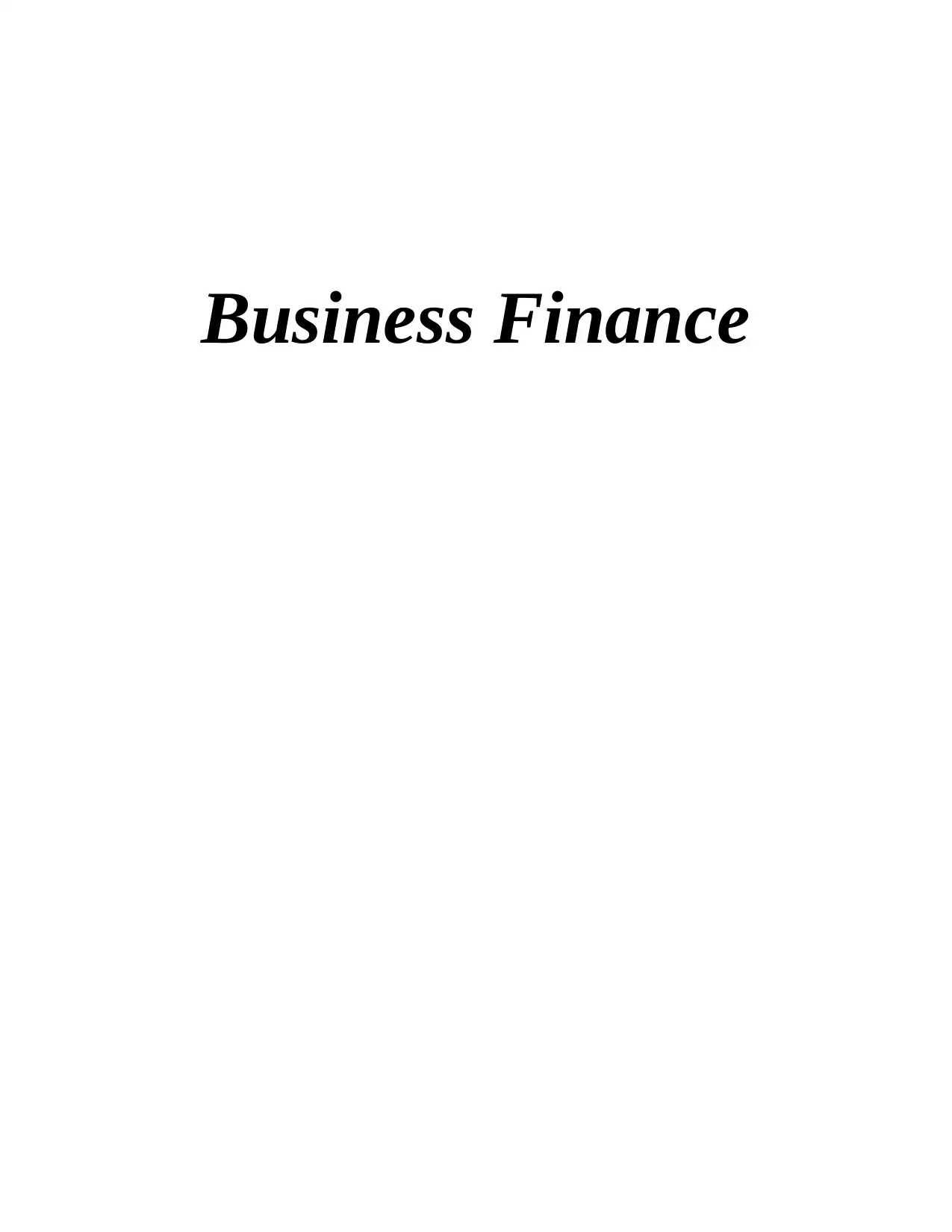
Business Finance
Secure Best Marks with AI Grader
Need help grading? Try our AI Grader for instant feedback on your assignments.
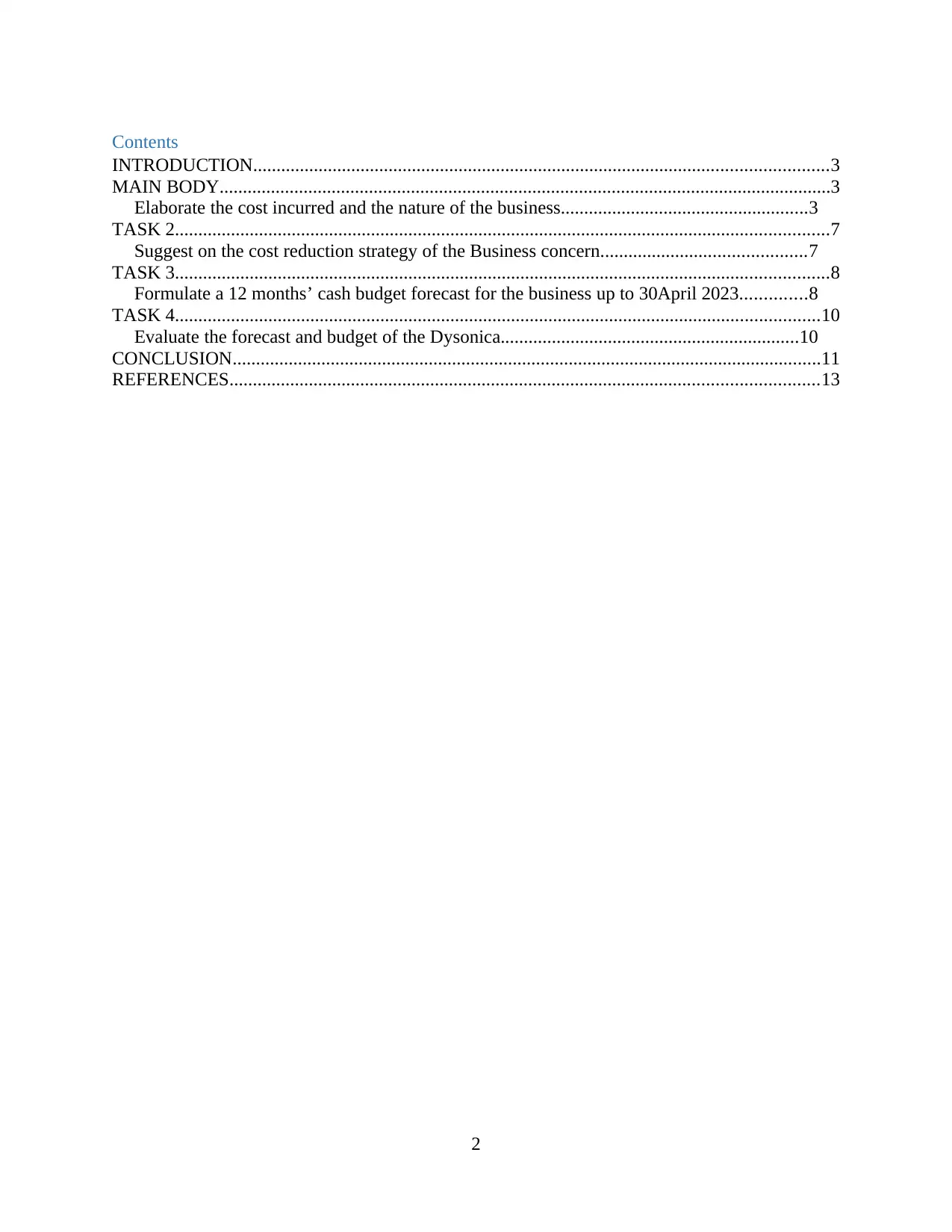
Contents
INTRODUCTION...........................................................................................................................3
MAIN BODY...................................................................................................................................3
Elaborate the cost incurred and the nature of the business.....................................................3
TASK 2............................................................................................................................................7
Suggest on the cost reduction strategy of the Business concern............................................7
TASK 3............................................................................................................................................8
Formulate a 12 months’ cash budget forecast for the business up to 30April 2023..............8
TASK 4..........................................................................................................................................10
Evaluate the forecast and budget of the Dysonica................................................................10
CONCLUSION..............................................................................................................................11
REFERENCES..............................................................................................................................13
2
INTRODUCTION...........................................................................................................................3
MAIN BODY...................................................................................................................................3
Elaborate the cost incurred and the nature of the business.....................................................3
TASK 2............................................................................................................................................7
Suggest on the cost reduction strategy of the Business concern............................................7
TASK 3............................................................................................................................................8
Formulate a 12 months’ cash budget forecast for the business up to 30April 2023..............8
TASK 4..........................................................................................................................................10
Evaluate the forecast and budget of the Dysonica................................................................10
CONCLUSION..............................................................................................................................11
REFERENCES..............................................................................................................................13
2
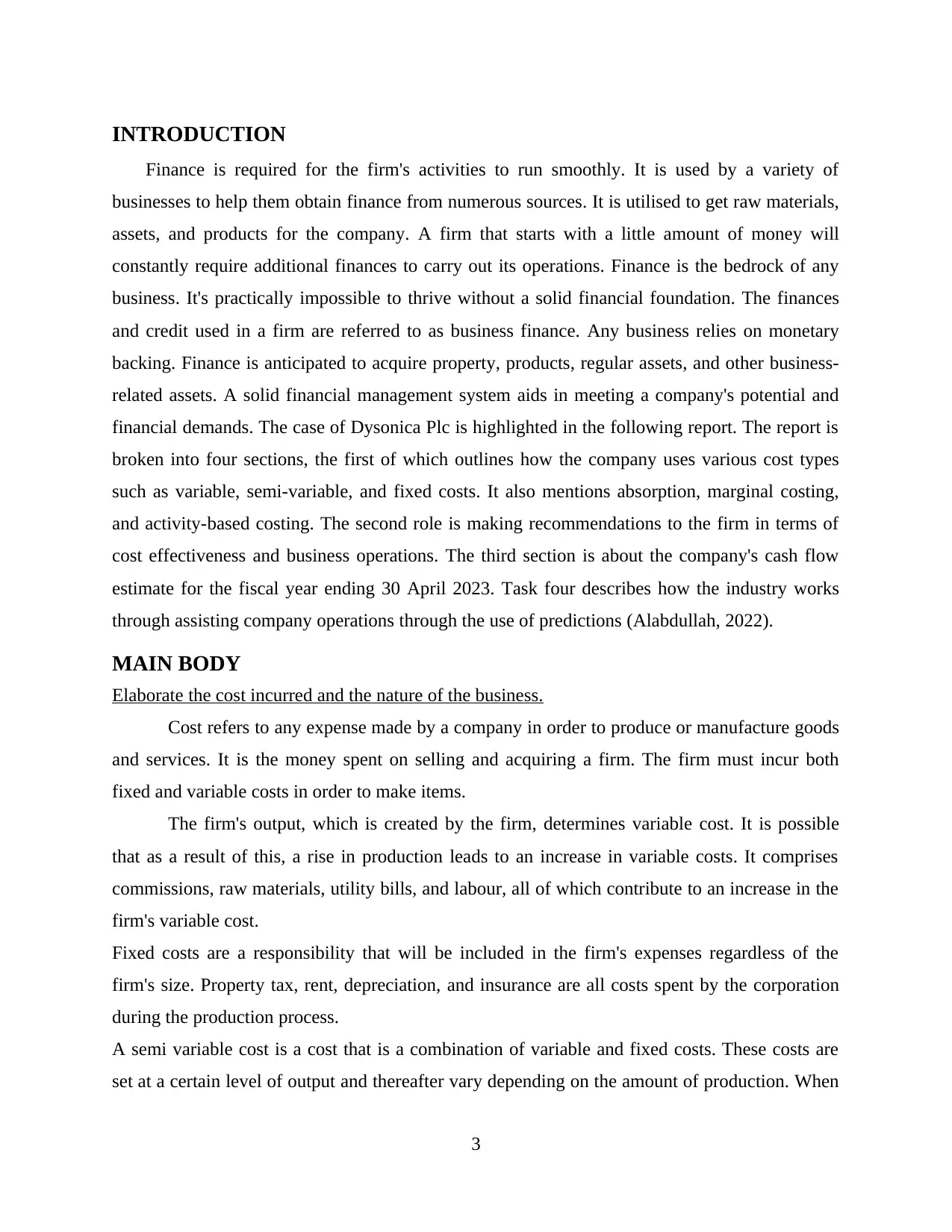
INTRODUCTION
Finance is required for the firm's activities to run smoothly. It is used by a variety of
businesses to help them obtain finance from numerous sources. It is utilised to get raw materials,
assets, and products for the company. A firm that starts with a little amount of money will
constantly require additional finances to carry out its operations. Finance is the bedrock of any
business. It's practically impossible to thrive without a solid financial foundation. The finances
and credit used in a firm are referred to as business finance. Any business relies on monetary
backing. Finance is anticipated to acquire property, products, regular assets, and other business-
related assets. A solid financial management system aids in meeting a company's potential and
financial demands. The case of Dysonica Plc is highlighted in the following report. The report is
broken into four sections, the first of which outlines how the company uses various cost types
such as variable, semi-variable, and fixed costs. It also mentions absorption, marginal costing,
and activity-based costing. The second role is making recommendations to the firm in terms of
cost effectiveness and business operations. The third section is about the company's cash flow
estimate for the fiscal year ending 30 April 2023. Task four describes how the industry works
through assisting company operations through the use of predictions (Alabdullah, 2022).
MAIN BODY
Elaborate the cost incurred and the nature of the business.
Cost refers to any expense made by a company in order to produce or manufacture goods
and services. It is the money spent on selling and acquiring a firm. The firm must incur both
fixed and variable costs in order to make items.
The firm's output, which is created by the firm, determines variable cost. It is possible
that as a result of this, a rise in production leads to an increase in variable costs. It comprises
commissions, raw materials, utility bills, and labour, all of which contribute to an increase in the
firm's variable cost.
Fixed costs are a responsibility that will be included in the firm's expenses regardless of the
firm's size. Property tax, rent, depreciation, and insurance are all costs spent by the corporation
during the production process.
A semi variable cost is a cost that is a combination of variable and fixed costs. These costs are
set at a certain level of output and thereafter vary depending on the amount of production. When
3
Finance is required for the firm's activities to run smoothly. It is used by a variety of
businesses to help them obtain finance from numerous sources. It is utilised to get raw materials,
assets, and products for the company. A firm that starts with a little amount of money will
constantly require additional finances to carry out its operations. Finance is the bedrock of any
business. It's practically impossible to thrive without a solid financial foundation. The finances
and credit used in a firm are referred to as business finance. Any business relies on monetary
backing. Finance is anticipated to acquire property, products, regular assets, and other business-
related assets. A solid financial management system aids in meeting a company's potential and
financial demands. The case of Dysonica Plc is highlighted in the following report. The report is
broken into four sections, the first of which outlines how the company uses various cost types
such as variable, semi-variable, and fixed costs. It also mentions absorption, marginal costing,
and activity-based costing. The second role is making recommendations to the firm in terms of
cost effectiveness and business operations. The third section is about the company's cash flow
estimate for the fiscal year ending 30 April 2023. Task four describes how the industry works
through assisting company operations through the use of predictions (Alabdullah, 2022).
MAIN BODY
Elaborate the cost incurred and the nature of the business.
Cost refers to any expense made by a company in order to produce or manufacture goods
and services. It is the money spent on selling and acquiring a firm. The firm must incur both
fixed and variable costs in order to make items.
The firm's output, which is created by the firm, determines variable cost. It is possible
that as a result of this, a rise in production leads to an increase in variable costs. It comprises
commissions, raw materials, utility bills, and labour, all of which contribute to an increase in the
firm's variable cost.
Fixed costs are a responsibility that will be included in the firm's expenses regardless of the
firm's size. Property tax, rent, depreciation, and insurance are all costs spent by the corporation
during the production process.
A semi variable cost is a cost that is a combination of variable and fixed costs. These costs are
set at a certain level of output and thereafter vary depending on the amount of production. When
3
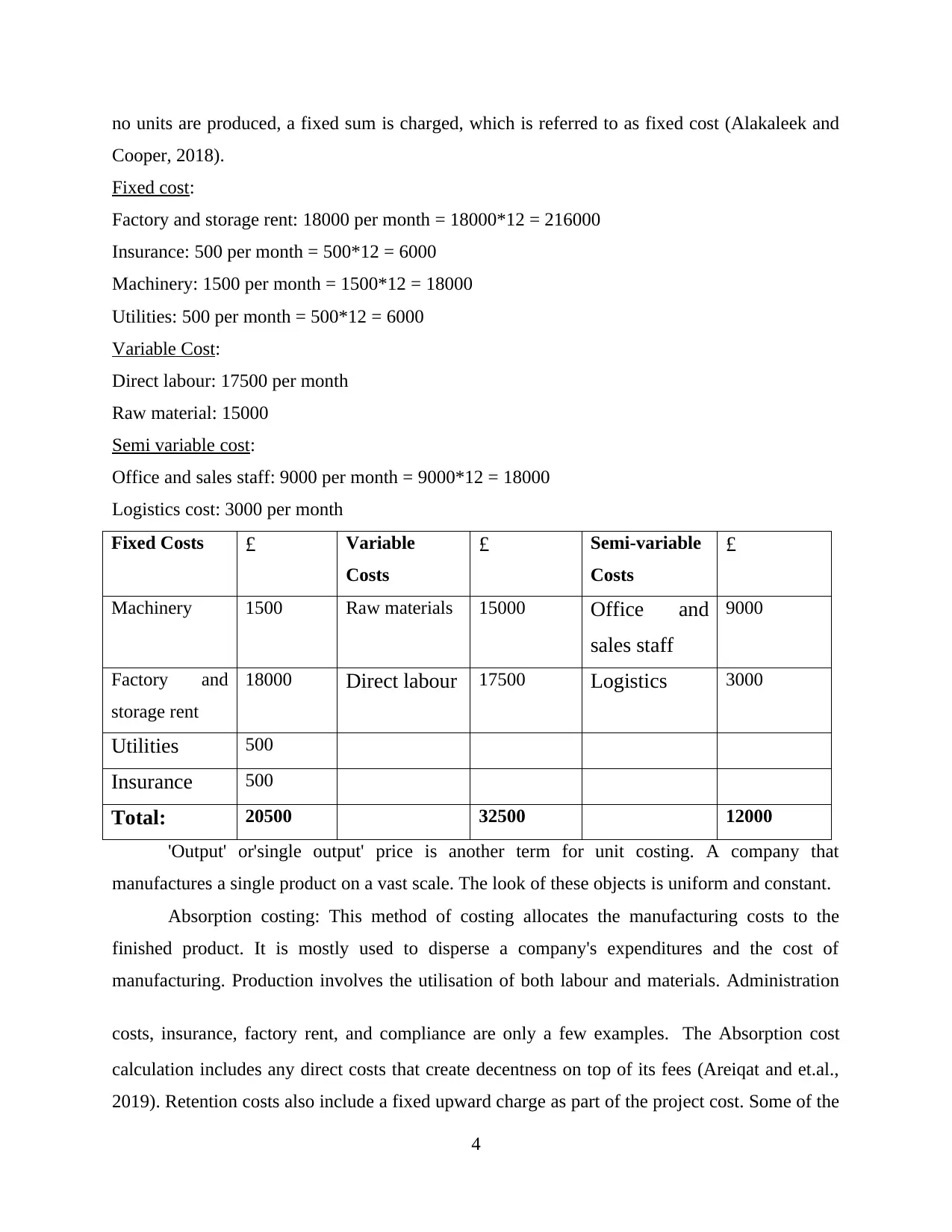
no units are produced, a fixed sum is charged, which is referred to as fixed cost (Alakaleek and
Cooper, 2018).
Fixed cost:
Factory and storage rent: 18000 per month = 18000*12 = 216000
Insurance: 500 per month = 500*12 = 6000
Machinery: 1500 per month = 1500*12 = 18000
Utilities: 500 per month = 500*12 = 6000
Variable Cost:
Direct labour: 17500 per month
Raw material: 15000
Semi variable cost:
Office and sales staff: 9000 per month = 9000*12 = 18000
Logistics cost: 3000 per month
Fixed Costs £ Variable
Costs
£ Semi-variable
Costs
£
Machinery 1500 Raw materials 15000 Office and
sales staff
9000
Factory and
storage rent
18000 Direct labour 17500 Logistics 3000
Utilities 500
Insurance 500
Total: 20500 32500 12000
'Output' or'single output' price is another term for unit costing. A company that
manufactures a single product on a vast scale. The look of these objects is uniform and constant.
Absorption costing: This method of costing allocates the manufacturing costs to the
finished product. It is mostly used to disperse a company's expenditures and the cost of
manufacturing. Production involves the utilisation of both labour and materials. Administration
costs, insurance, factory rent, and compliance are only a few examples. The Absorption cost
calculation includes any direct costs that create decentness on top of its fees (Areiqat and et.al.,
2019). Retention costs also include a fixed upward charge as part of the project cost. Some of the
4
Cooper, 2018).
Fixed cost:
Factory and storage rent: 18000 per month = 18000*12 = 216000
Insurance: 500 per month = 500*12 = 6000
Machinery: 1500 per month = 1500*12 = 18000
Utilities: 500 per month = 500*12 = 6000
Variable Cost:
Direct labour: 17500 per month
Raw material: 15000
Semi variable cost:
Office and sales staff: 9000 per month = 9000*12 = 18000
Logistics cost: 3000 per month
Fixed Costs £ Variable
Costs
£ Semi-variable
Costs
£
Machinery 1500 Raw materials 15000 Office and
sales staff
9000
Factory and
storage rent
18000 Direct labour 17500 Logistics 3000
Utilities 500
Insurance 500
Total: 20500 32500 12000
'Output' or'single output' price is another term for unit costing. A company that
manufactures a single product on a vast scale. The look of these objects is uniform and constant.
Absorption costing: This method of costing allocates the manufacturing costs to the
finished product. It is mostly used to disperse a company's expenditures and the cost of
manufacturing. Production involves the utilisation of both labour and materials. Administration
costs, insurance, factory rent, and compliance are only a few examples. The Absorption cost
calculation includes any direct costs that create decentness on top of its fees (Areiqat and et.al.,
2019). Retention costs also include a fixed upward charge as part of the project cost. Some of the
4
Secure Best Marks with AI Grader
Need help grading? Try our AI Grader for instant feedback on your assignments.
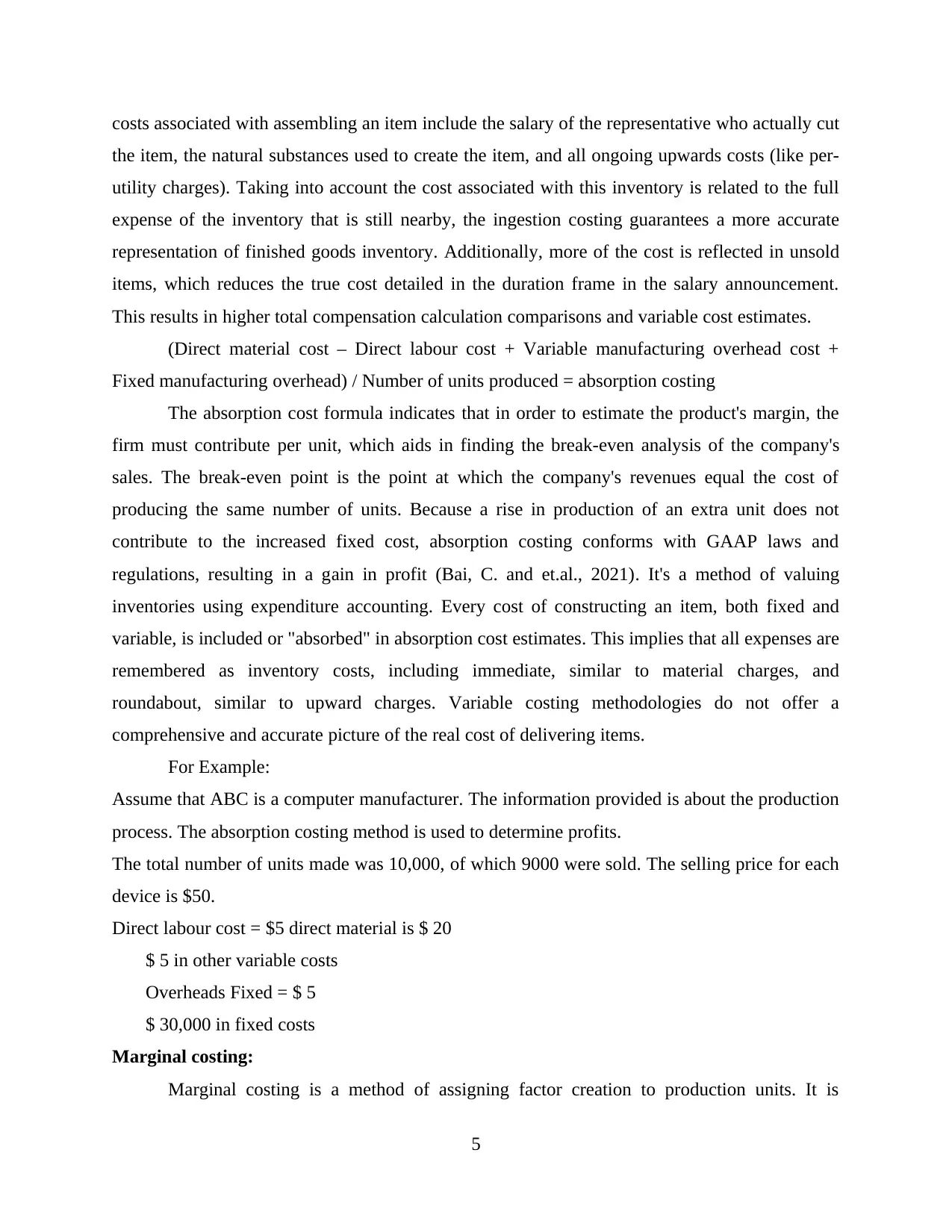
costs associated with assembling an item include the salary of the representative who actually cut
the item, the natural substances used to create the item, and all ongoing upwards costs (like per-
utility charges). Taking into account the cost associated with this inventory is related to the full
expense of the inventory that is still nearby, the ingestion costing guarantees a more accurate
representation of finished goods inventory. Additionally, more of the cost is reflected in unsold
items, which reduces the true cost detailed in the duration frame in the salary announcement.
This results in higher total compensation calculation comparisons and variable cost estimates.
(Direct material cost – Direct labour cost + Variable manufacturing overhead cost +
Fixed manufacturing overhead) / Number of units produced = absorption costing
The absorption cost formula indicates that in order to estimate the product's margin, the
firm must contribute per unit, which aids in finding the break-even analysis of the company's
sales. The break-even point is the point at which the company's revenues equal the cost of
producing the same number of units. Because a rise in production of an extra unit does not
contribute to the increased fixed cost, absorption costing conforms with GAAP laws and
regulations, resulting in a gain in profit (Bai, C. and et.al., 2021). It's a method of valuing
inventories using expenditure accounting. Every cost of constructing an item, both fixed and
variable, is included or "absorbed" in absorption cost estimates. This implies that all expenses are
remembered as inventory costs, including immediate, similar to material charges, and
roundabout, similar to upward charges. Variable costing methodologies do not offer a
comprehensive and accurate picture of the real cost of delivering items.
For Example:
Assume that ABC is a computer manufacturer. The information provided is about the production
process. The absorption costing method is used to determine profits.
The total number of units made was 10,000, of which 9000 were sold. The selling price for each
device is $50.
Direct labour cost = $5 direct material is $ 20
$ 5 in other variable costs
Overheads Fixed = $ 5
$ 30,000 in fixed costs
Marginal costing:
Marginal costing is a method of assigning factor creation to production units. It is
5
the item, the natural substances used to create the item, and all ongoing upwards costs (like per-
utility charges). Taking into account the cost associated with this inventory is related to the full
expense of the inventory that is still nearby, the ingestion costing guarantees a more accurate
representation of finished goods inventory. Additionally, more of the cost is reflected in unsold
items, which reduces the true cost detailed in the duration frame in the salary announcement.
This results in higher total compensation calculation comparisons and variable cost estimates.
(Direct material cost – Direct labour cost + Variable manufacturing overhead cost +
Fixed manufacturing overhead) / Number of units produced = absorption costing
The absorption cost formula indicates that in order to estimate the product's margin, the
firm must contribute per unit, which aids in finding the break-even analysis of the company's
sales. The break-even point is the point at which the company's revenues equal the cost of
producing the same number of units. Because a rise in production of an extra unit does not
contribute to the increased fixed cost, absorption costing conforms with GAAP laws and
regulations, resulting in a gain in profit (Bai, C. and et.al., 2021). It's a method of valuing
inventories using expenditure accounting. Every cost of constructing an item, both fixed and
variable, is included or "absorbed" in absorption cost estimates. This implies that all expenses are
remembered as inventory costs, including immediate, similar to material charges, and
roundabout, similar to upward charges. Variable costing methodologies do not offer a
comprehensive and accurate picture of the real cost of delivering items.
For Example:
Assume that ABC is a computer manufacturer. The information provided is about the production
process. The absorption costing method is used to determine profits.
The total number of units made was 10,000, of which 9000 were sold. The selling price for each
device is $50.
Direct labour cost = $5 direct material is $ 20
$ 5 in other variable costs
Overheads Fixed = $ 5
$ 30,000 in fixed costs
Marginal costing:
Marginal costing is a method of assigning factor creation to production units. It is
5
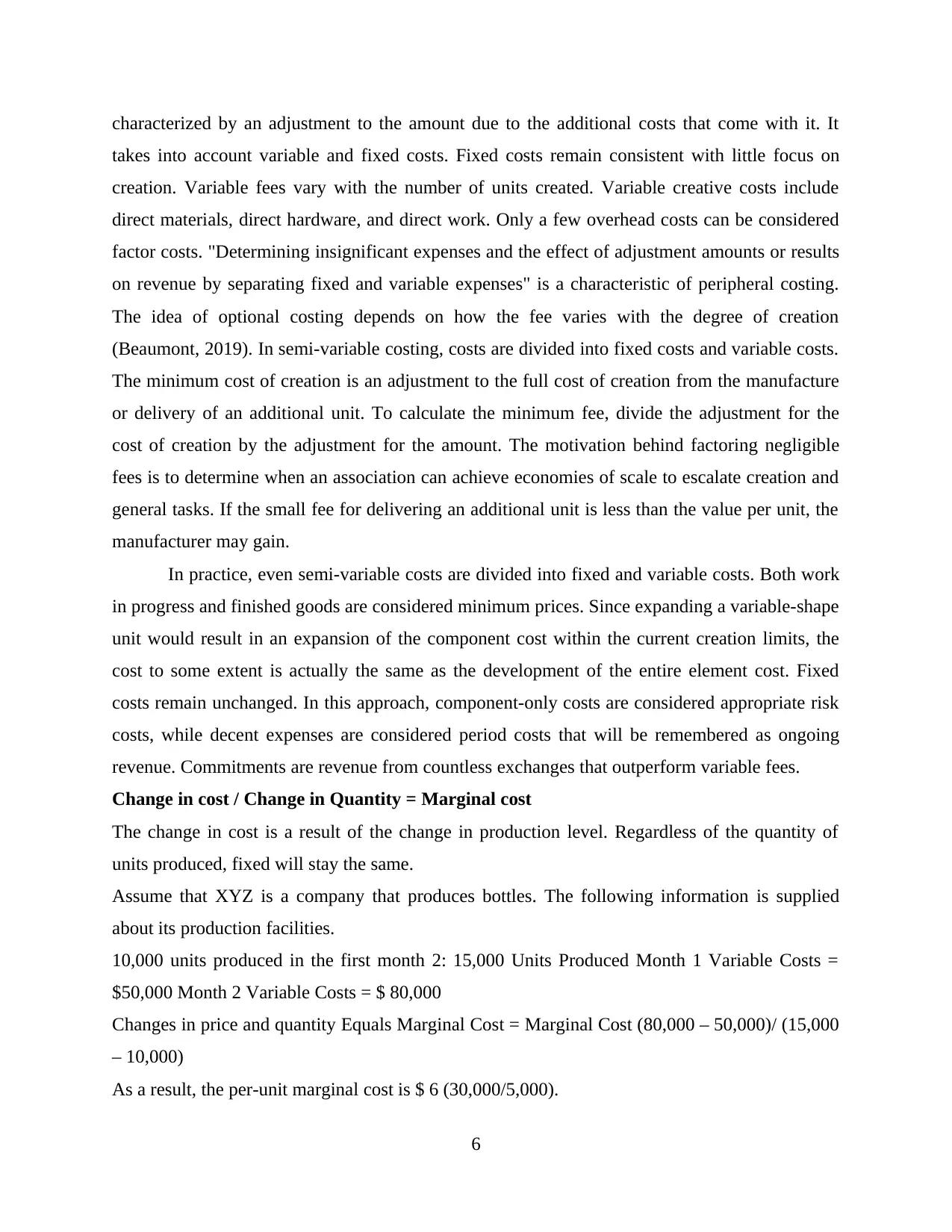
characterized by an adjustment to the amount due to the additional costs that come with it. It
takes into account variable and fixed costs. Fixed costs remain consistent with little focus on
creation. Variable fees vary with the number of units created. Variable creative costs include
direct materials, direct hardware, and direct work. Only a few overhead costs can be considered
factor costs. "Determining insignificant expenses and the effect of adjustment amounts or results
on revenue by separating fixed and variable expenses" is a characteristic of peripheral costing.
The idea of optional costing depends on how the fee varies with the degree of creation
(Beaumont, 2019). In semi-variable costing, costs are divided into fixed costs and variable costs.
The minimum cost of creation is an adjustment to the full cost of creation from the manufacture
or delivery of an additional unit. To calculate the minimum fee, divide the adjustment for the
cost of creation by the adjustment for the amount. The motivation behind factoring negligible
fees is to determine when an association can achieve economies of scale to escalate creation and
general tasks. If the small fee for delivering an additional unit is less than the value per unit, the
manufacturer may gain.
In practice, even semi-variable costs are divided into fixed and variable costs. Both work
in progress and finished goods are considered minimum prices. Since expanding a variable-shape
unit would result in an expansion of the component cost within the current creation limits, the
cost to some extent is actually the same as the development of the entire element cost. Fixed
costs remain unchanged. In this approach, component-only costs are considered appropriate risk
costs, while decent expenses are considered period costs that will be remembered as ongoing
revenue. Commitments are revenue from countless exchanges that outperform variable fees.
Change in cost / Change in Quantity = Marginal cost
The change in cost is a result of the change in production level. Regardless of the quantity of
units produced, fixed will stay the same.
Assume that XYZ is a company that produces bottles. The following information is supplied
about its production facilities.
10,000 units produced in the first month 2: 15,000 Units Produced Month 1 Variable Costs =
$50,000 Month 2 Variable Costs = $ 80,000
Changes in price and quantity Equals Marginal Cost = Marginal Cost (80,000 – 50,000)/ (15,000
– 10,000)
As a result, the per-unit marginal cost is $ 6 (30,000/5,000).
6
takes into account variable and fixed costs. Fixed costs remain consistent with little focus on
creation. Variable fees vary with the number of units created. Variable creative costs include
direct materials, direct hardware, and direct work. Only a few overhead costs can be considered
factor costs. "Determining insignificant expenses and the effect of adjustment amounts or results
on revenue by separating fixed and variable expenses" is a characteristic of peripheral costing.
The idea of optional costing depends on how the fee varies with the degree of creation
(Beaumont, 2019). In semi-variable costing, costs are divided into fixed costs and variable costs.
The minimum cost of creation is an adjustment to the full cost of creation from the manufacture
or delivery of an additional unit. To calculate the minimum fee, divide the adjustment for the
cost of creation by the adjustment for the amount. The motivation behind factoring negligible
fees is to determine when an association can achieve economies of scale to escalate creation and
general tasks. If the small fee for delivering an additional unit is less than the value per unit, the
manufacturer may gain.
In practice, even semi-variable costs are divided into fixed and variable costs. Both work
in progress and finished goods are considered minimum prices. Since expanding a variable-shape
unit would result in an expansion of the component cost within the current creation limits, the
cost to some extent is actually the same as the development of the entire element cost. Fixed
costs remain unchanged. In this approach, component-only costs are considered appropriate risk
costs, while decent expenses are considered period costs that will be remembered as ongoing
revenue. Commitments are revenue from countless exchanges that outperform variable fees.
Change in cost / Change in Quantity = Marginal cost
The change in cost is a result of the change in production level. Regardless of the quantity of
units produced, fixed will stay the same.
Assume that XYZ is a company that produces bottles. The following information is supplied
about its production facilities.
10,000 units produced in the first month 2: 15,000 Units Produced Month 1 Variable Costs =
$50,000 Month 2 Variable Costs = $ 80,000
Changes in price and quantity Equals Marginal Cost = Marginal Cost (80,000 – 50,000)/ (15,000
– 10,000)
As a result, the per-unit marginal cost is $ 6 (30,000/5,000).
6
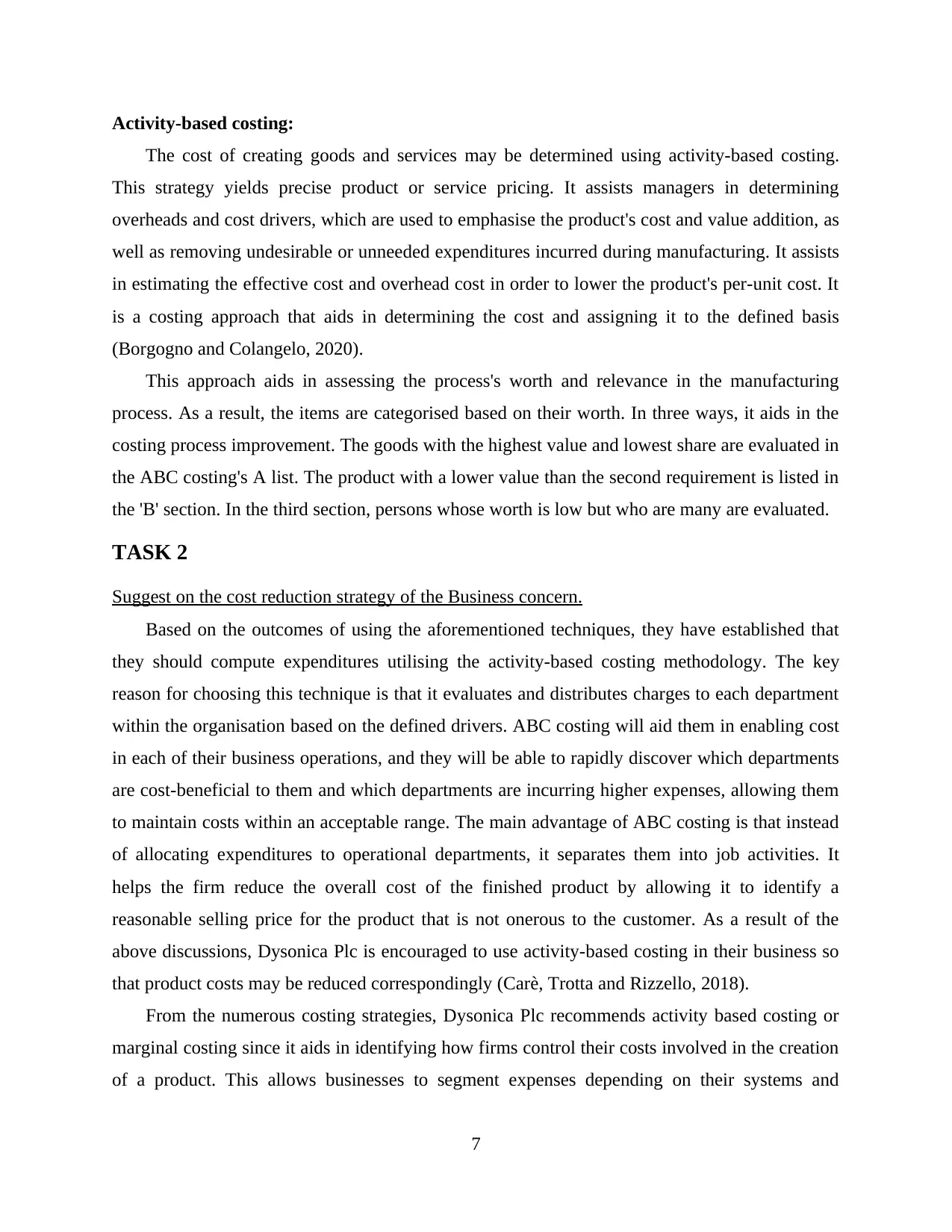
Activity-based costing:
The cost of creating goods and services may be determined using activity-based costing.
This strategy yields precise product or service pricing. It assists managers in determining
overheads and cost drivers, which are used to emphasise the product's cost and value addition, as
well as removing undesirable or unneeded expenditures incurred during manufacturing. It assists
in estimating the effective cost and overhead cost in order to lower the product's per-unit cost. It
is a costing approach that aids in determining the cost and assigning it to the defined basis
(Borgogno and Colangelo, 2020).
This approach aids in assessing the process's worth and relevance in the manufacturing
process. As a result, the items are categorised based on their worth. In three ways, it aids in the
costing process improvement. The goods with the highest value and lowest share are evaluated in
the ABC costing's A list. The product with a lower value than the second requirement is listed in
the 'B' section. In the third section, persons whose worth is low but who are many are evaluated.
TASK 2
Suggest on the cost reduction strategy of the Business concern.
Based on the outcomes of using the aforementioned techniques, they have established that
they should compute expenditures utilising the activity-based costing methodology. The key
reason for choosing this technique is that it evaluates and distributes charges to each department
within the organisation based on the defined drivers. ABC costing will aid them in enabling cost
in each of their business operations, and they will be able to rapidly discover which departments
are cost-beneficial to them and which departments are incurring higher expenses, allowing them
to maintain costs within an acceptable range. The main advantage of ABC costing is that instead
of allocating expenditures to operational departments, it separates them into job activities. It
helps the firm reduce the overall cost of the finished product by allowing it to identify a
reasonable selling price for the product that is not onerous to the customer. As a result of the
above discussions, Dysonica Plc is encouraged to use activity-based costing in their business so
that product costs may be reduced correspondingly (Carè, Trotta and Rizzello, 2018).
From the numerous costing strategies, Dysonica Plc recommends activity based costing or
marginal costing since it aids in identifying how firms control their costs involved in the creation
of a product. This allows businesses to segment expenses depending on their systems and
7
The cost of creating goods and services may be determined using activity-based costing.
This strategy yields precise product or service pricing. It assists managers in determining
overheads and cost drivers, which are used to emphasise the product's cost and value addition, as
well as removing undesirable or unneeded expenditures incurred during manufacturing. It assists
in estimating the effective cost and overhead cost in order to lower the product's per-unit cost. It
is a costing approach that aids in determining the cost and assigning it to the defined basis
(Borgogno and Colangelo, 2020).
This approach aids in assessing the process's worth and relevance in the manufacturing
process. As a result, the items are categorised based on their worth. In three ways, it aids in the
costing process improvement. The goods with the highest value and lowest share are evaluated in
the ABC costing's A list. The product with a lower value than the second requirement is listed in
the 'B' section. In the third section, persons whose worth is low but who are many are evaluated.
TASK 2
Suggest on the cost reduction strategy of the Business concern.
Based on the outcomes of using the aforementioned techniques, they have established that
they should compute expenditures utilising the activity-based costing methodology. The key
reason for choosing this technique is that it evaluates and distributes charges to each department
within the organisation based on the defined drivers. ABC costing will aid them in enabling cost
in each of their business operations, and they will be able to rapidly discover which departments
are cost-beneficial to them and which departments are incurring higher expenses, allowing them
to maintain costs within an acceptable range. The main advantage of ABC costing is that instead
of allocating expenditures to operational departments, it separates them into job activities. It
helps the firm reduce the overall cost of the finished product by allowing it to identify a
reasonable selling price for the product that is not onerous to the customer. As a result of the
above discussions, Dysonica Plc is encouraged to use activity-based costing in their business so
that product costs may be reduced correspondingly (Carè, Trotta and Rizzello, 2018).
From the numerous costing strategies, Dysonica Plc recommends activity based costing or
marginal costing since it aids in identifying how firms control their costs involved in the creation
of a product. This allows businesses to segment expenses depending on their systems and
7
Paraphrase This Document
Need a fresh take? Get an instant paraphrase of this document with our AI Paraphraser
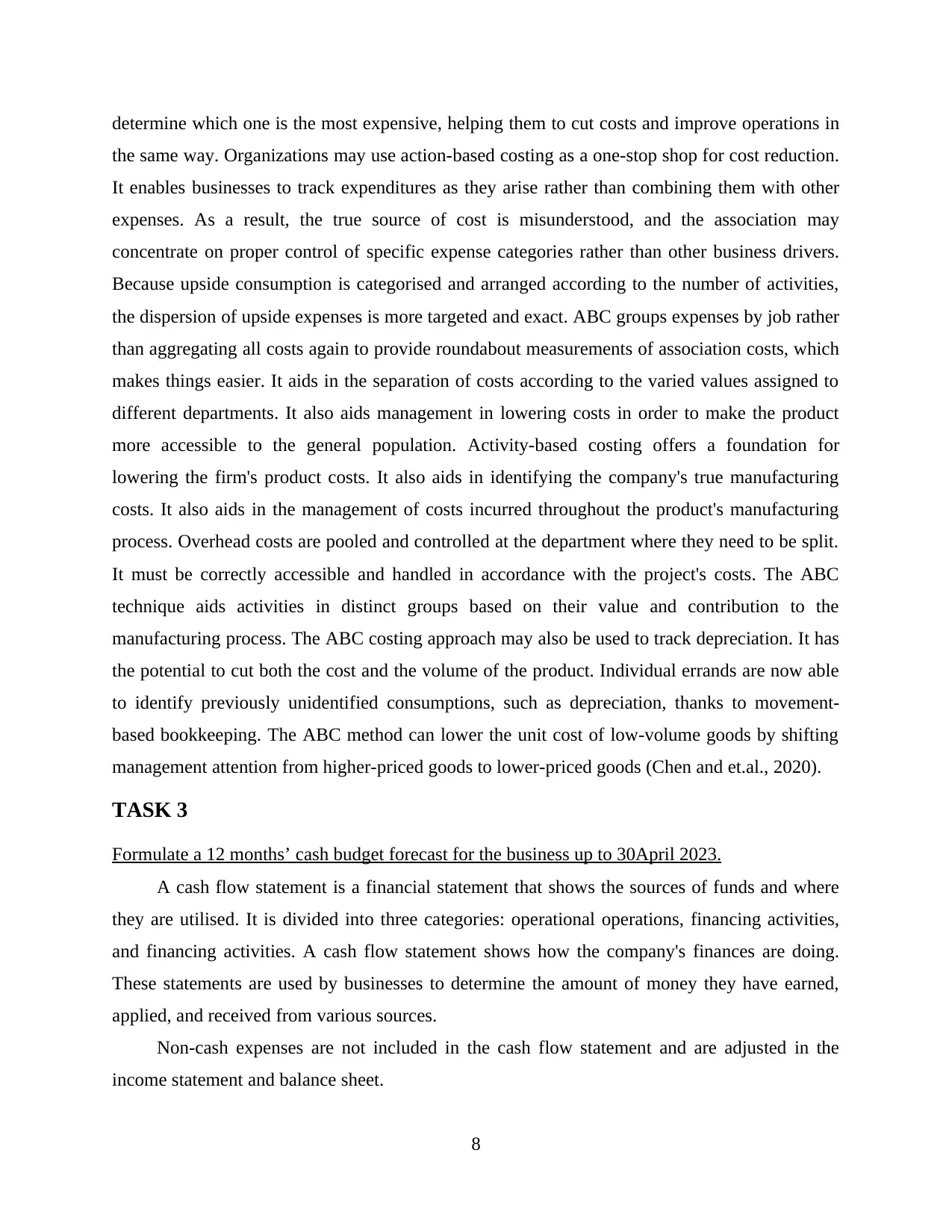
determine which one is the most expensive, helping them to cut costs and improve operations in
the same way. Organizations may use action-based costing as a one-stop shop for cost reduction.
It enables businesses to track expenditures as they arise rather than combining them with other
expenses. As a result, the true source of cost is misunderstood, and the association may
concentrate on proper control of specific expense categories rather than other business drivers.
Because upside consumption is categorised and arranged according to the number of activities,
the dispersion of upside expenses is more targeted and exact. ABC groups expenses by job rather
than aggregating all costs again to provide roundabout measurements of association costs, which
makes things easier. It aids in the separation of costs according to the varied values assigned to
different departments. It also aids management in lowering costs in order to make the product
more accessible to the general population. Activity-based costing offers a foundation for
lowering the firm's product costs. It also aids in identifying the company's true manufacturing
costs. It also aids in the management of costs incurred throughout the product's manufacturing
process. Overhead costs are pooled and controlled at the department where they need to be split.
It must be correctly accessible and handled in accordance with the project's costs. The ABC
technique aids activities in distinct groups based on their value and contribution to the
manufacturing process. The ABC costing approach may also be used to track depreciation. It has
the potential to cut both the cost and the volume of the product. Individual errands are now able
to identify previously unidentified consumptions, such as depreciation, thanks to movement-
based bookkeeping. The ABC method can lower the unit cost of low-volume goods by shifting
management attention from higher-priced goods to lower-priced goods (Chen and et.al., 2020).
TASK 3
Formulate a 12 months’ cash budget forecast for the business up to 30April 2023.
A cash flow statement is a financial statement that shows the sources of funds and where
they are utilised. It is divided into three categories: operational operations, financing activities,
and financing activities. A cash flow statement shows how the company's finances are doing.
These statements are used by businesses to determine the amount of money they have earned,
applied, and received from various sources.
Non-cash expenses are not included in the cash flow statement and are adjusted in the
income statement and balance sheet.
8
the same way. Organizations may use action-based costing as a one-stop shop for cost reduction.
It enables businesses to track expenditures as they arise rather than combining them with other
expenses. As a result, the true source of cost is misunderstood, and the association may
concentrate on proper control of specific expense categories rather than other business drivers.
Because upside consumption is categorised and arranged according to the number of activities,
the dispersion of upside expenses is more targeted and exact. ABC groups expenses by job rather
than aggregating all costs again to provide roundabout measurements of association costs, which
makes things easier. It aids in the separation of costs according to the varied values assigned to
different departments. It also aids management in lowering costs in order to make the product
more accessible to the general population. Activity-based costing offers a foundation for
lowering the firm's product costs. It also aids in identifying the company's true manufacturing
costs. It also aids in the management of costs incurred throughout the product's manufacturing
process. Overhead costs are pooled and controlled at the department where they need to be split.
It must be correctly accessible and handled in accordance with the project's costs. The ABC
technique aids activities in distinct groups based on their value and contribution to the
manufacturing process. The ABC costing approach may also be used to track depreciation. It has
the potential to cut both the cost and the volume of the product. Individual errands are now able
to identify previously unidentified consumptions, such as depreciation, thanks to movement-
based bookkeeping. The ABC method can lower the unit cost of low-volume goods by shifting
management attention from higher-priced goods to lower-priced goods (Chen and et.al., 2020).
TASK 3
Formulate a 12 months’ cash budget forecast for the business up to 30April 2023.
A cash flow statement is a financial statement that shows the sources of funds and where
they are utilised. It is divided into three categories: operational operations, financing activities,
and financing activities. A cash flow statement shows how the company's finances are doing.
These statements are used by businesses to determine the amount of money they have earned,
applied, and received from various sources.
Non-cash expenses are not included in the cash flow statement and are adjusted in the
income statement and balance sheet.
8
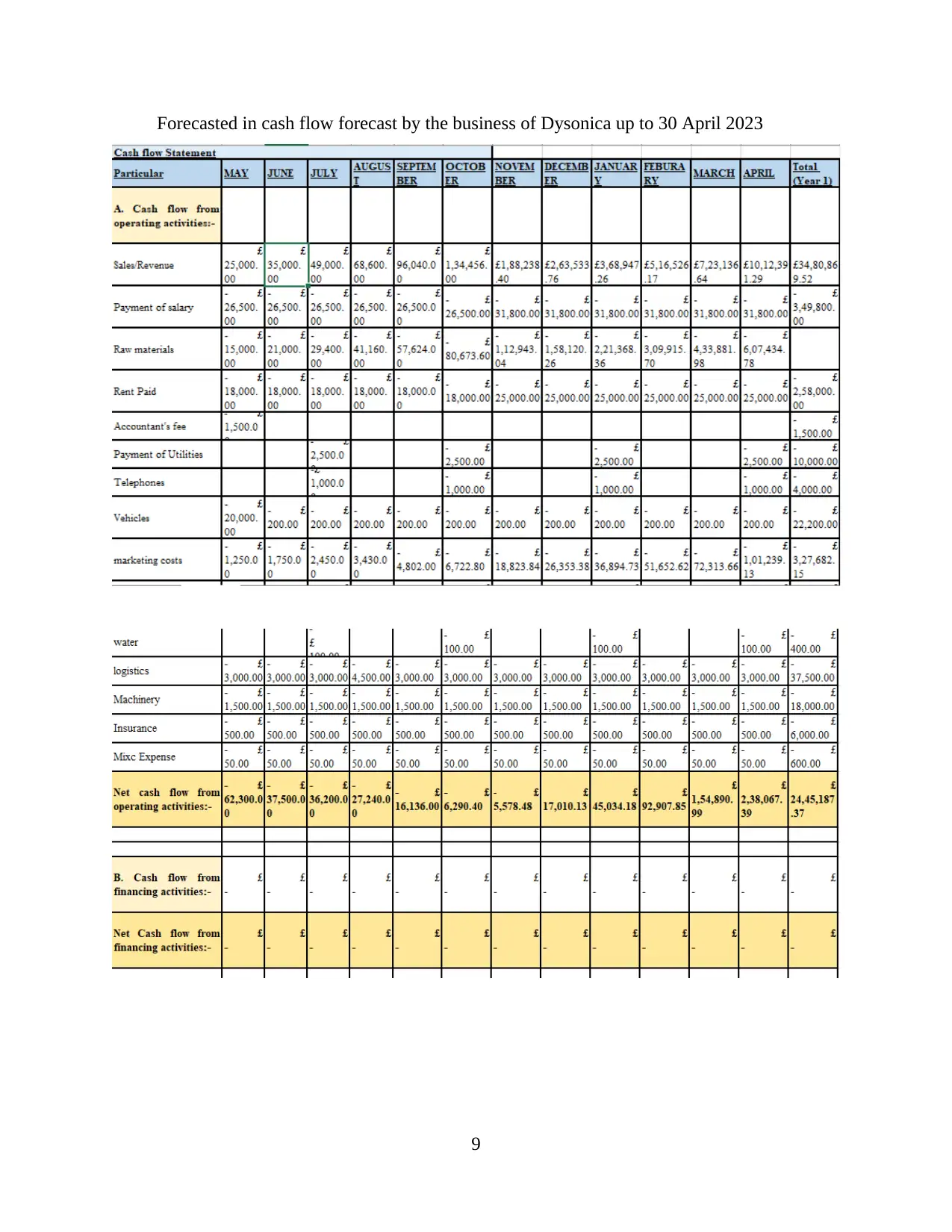
Forecasted in cash flow forecast by the business of Dysonica up to 30 April 2023
9
9
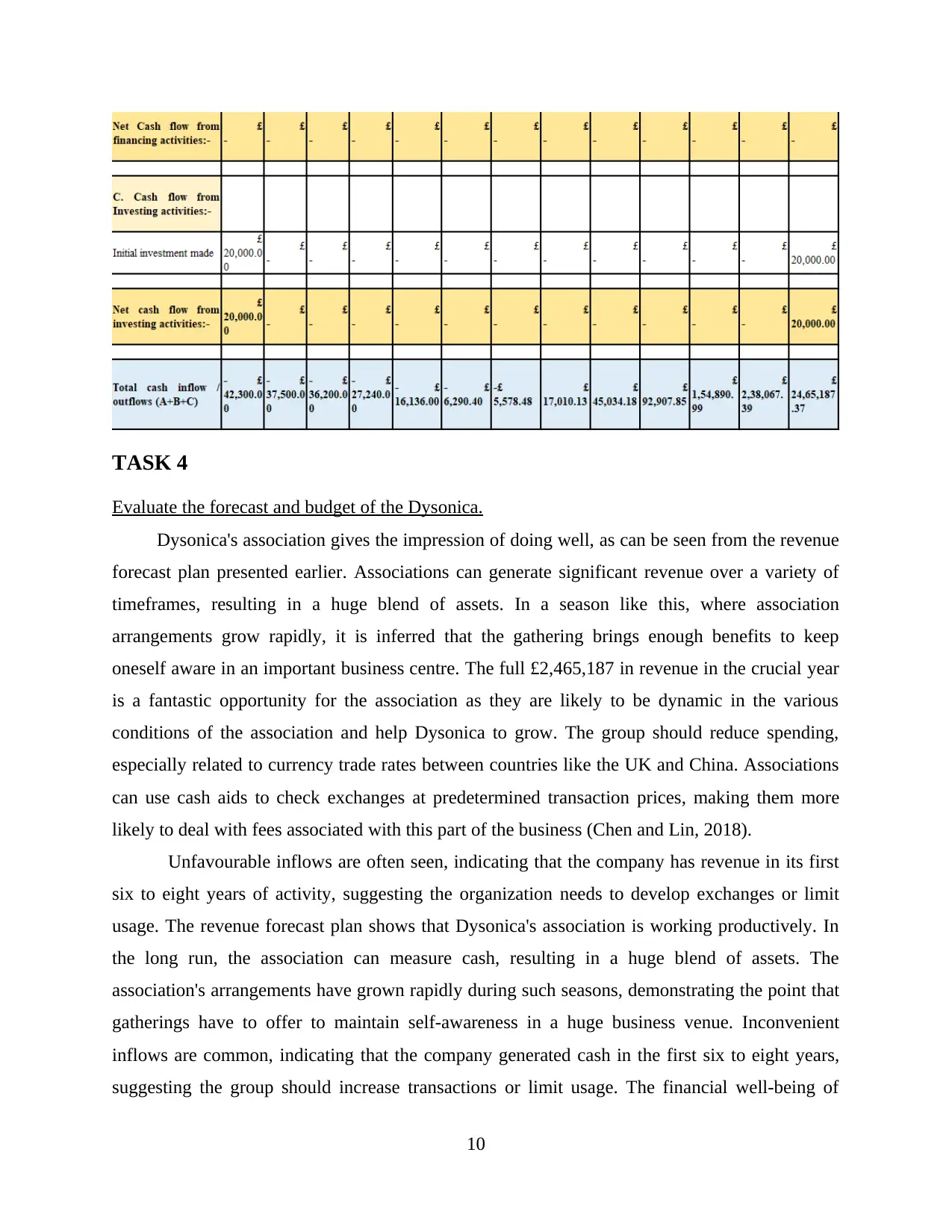
TASK 4
Evaluate the forecast and budget of the Dysonica.
Dysonica's association gives the impression of doing well, as can be seen from the revenue
forecast plan presented earlier. Associations can generate significant revenue over a variety of
timeframes, resulting in a huge blend of assets. In a season like this, where association
arrangements grow rapidly, it is inferred that the gathering brings enough benefits to keep
oneself aware in an important business centre. The full £2,465,187 in revenue in the crucial year
is a fantastic opportunity for the association as they are likely to be dynamic in the various
conditions of the association and help Dysonica to grow. The group should reduce spending,
especially related to currency trade rates between countries like the UK and China. Associations
can use cash aids to check exchanges at predetermined transaction prices, making them more
likely to deal with fees associated with this part of the business (Chen and Lin, 2018).
Unfavourable inflows are often seen, indicating that the company has revenue in its first
six to eight years of activity, suggesting the organization needs to develop exchanges or limit
usage. The revenue forecast plan shows that Dysonica's association is working productively. In
the long run, the association can measure cash, resulting in a huge blend of assets. The
association's arrangements have grown rapidly during such seasons, demonstrating the point that
gatherings have to offer to maintain self-awareness in a huge business venue. Inconvenient
inflows are common, indicating that the company generated cash in the first six to eight years,
suggesting the group should increase transactions or limit usage. The financial well-being of
10
Evaluate the forecast and budget of the Dysonica.
Dysonica's association gives the impression of doing well, as can be seen from the revenue
forecast plan presented earlier. Associations can generate significant revenue over a variety of
timeframes, resulting in a huge blend of assets. In a season like this, where association
arrangements grow rapidly, it is inferred that the gathering brings enough benefits to keep
oneself aware in an important business centre. The full £2,465,187 in revenue in the crucial year
is a fantastic opportunity for the association as they are likely to be dynamic in the various
conditions of the association and help Dysonica to grow. The group should reduce spending,
especially related to currency trade rates between countries like the UK and China. Associations
can use cash aids to check exchanges at predetermined transaction prices, making them more
likely to deal with fees associated with this part of the business (Chen and Lin, 2018).
Unfavourable inflows are often seen, indicating that the company has revenue in its first
six to eight years of activity, suggesting the organization needs to develop exchanges or limit
usage. The revenue forecast plan shows that Dysonica's association is working productively. In
the long run, the association can measure cash, resulting in a huge blend of assets. The
association's arrangements have grown rapidly during such seasons, demonstrating the point that
gatherings have to offer to maintain self-awareness in a huge business venue. Inconvenient
inflows are common, indicating that the company generated cash in the first six to eight years,
suggesting the group should increase transactions or limit usage. The financial well-being of
10
Secure Best Marks with AI Grader
Need help grading? Try our AI Grader for instant feedback on your assignments.
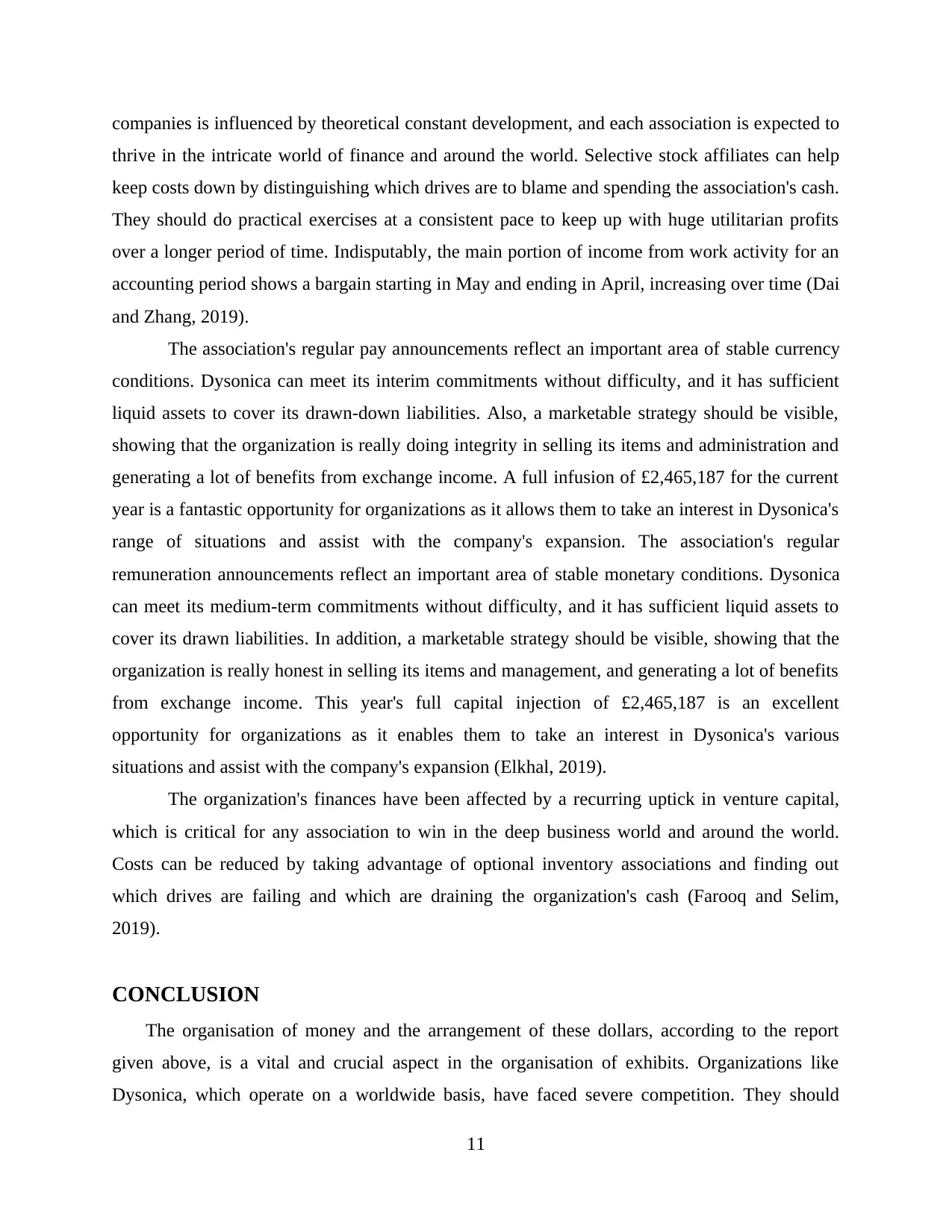
companies is influenced by theoretical constant development, and each association is expected to
thrive in the intricate world of finance and around the world. Selective stock affiliates can help
keep costs down by distinguishing which drives are to blame and spending the association's cash.
They should do practical exercises at a consistent pace to keep up with huge utilitarian profits
over a longer period of time. Indisputably, the main portion of income from work activity for an
accounting period shows a bargain starting in May and ending in April, increasing over time (Dai
and Zhang, 2019).
The association's regular pay announcements reflect an important area of stable currency
conditions. Dysonica can meet its interim commitments without difficulty, and it has sufficient
liquid assets to cover its drawn-down liabilities. Also, a marketable strategy should be visible,
showing that the organization is really doing integrity in selling its items and administration and
generating a lot of benefits from exchange income. A full infusion of £2,465,187 for the current
year is a fantastic opportunity for organizations as it allows them to take an interest in Dysonica's
range of situations and assist with the company's expansion. The association's regular
remuneration announcements reflect an important area of stable monetary conditions. Dysonica
can meet its medium-term commitments without difficulty, and it has sufficient liquid assets to
cover its drawn liabilities. In addition, a marketable strategy should be visible, showing that the
organization is really honest in selling its items and management, and generating a lot of benefits
from exchange income. This year's full capital injection of £2,465,187 is an excellent
opportunity for organizations as it enables them to take an interest in Dysonica's various
situations and assist with the company's expansion (Elkhal, 2019).
The organization's finances have been affected by a recurring uptick in venture capital,
which is critical for any association to win in the deep business world and around the world.
Costs can be reduced by taking advantage of optional inventory associations and finding out
which drives are failing and which are draining the organization's cash (Farooq and Selim,
2019).
CONCLUSION
The organisation of money and the arrangement of these dollars, according to the report
given above, is a vital and crucial aspect in the organisation of exhibits. Organizations like
Dysonica, which operate on a worldwide basis, have faced severe competition. They should
11
thrive in the intricate world of finance and around the world. Selective stock affiliates can help
keep costs down by distinguishing which drives are to blame and spending the association's cash.
They should do practical exercises at a consistent pace to keep up with huge utilitarian profits
over a longer period of time. Indisputably, the main portion of income from work activity for an
accounting period shows a bargain starting in May and ending in April, increasing over time (Dai
and Zhang, 2019).
The association's regular pay announcements reflect an important area of stable currency
conditions. Dysonica can meet its interim commitments without difficulty, and it has sufficient
liquid assets to cover its drawn-down liabilities. Also, a marketable strategy should be visible,
showing that the organization is really doing integrity in selling its items and administration and
generating a lot of benefits from exchange income. A full infusion of £2,465,187 for the current
year is a fantastic opportunity for organizations as it allows them to take an interest in Dysonica's
range of situations and assist with the company's expansion. The association's regular
remuneration announcements reflect an important area of stable monetary conditions. Dysonica
can meet its medium-term commitments without difficulty, and it has sufficient liquid assets to
cover its drawn liabilities. In addition, a marketable strategy should be visible, showing that the
organization is really honest in selling its items and management, and generating a lot of benefits
from exchange income. This year's full capital injection of £2,465,187 is an excellent
opportunity for organizations as it enables them to take an interest in Dysonica's various
situations and assist with the company's expansion (Elkhal, 2019).
The organization's finances have been affected by a recurring uptick in venture capital,
which is critical for any association to win in the deep business world and around the world.
Costs can be reduced by taking advantage of optional inventory associations and finding out
which drives are failing and which are draining the organization's cash (Farooq and Selim,
2019).
CONCLUSION
The organisation of money and the arrangement of these dollars, according to the report
given above, is a vital and crucial aspect in the organisation of exhibits. Organizations like
Dysonica, which operate on a worldwide basis, have faced severe competition. They should
11
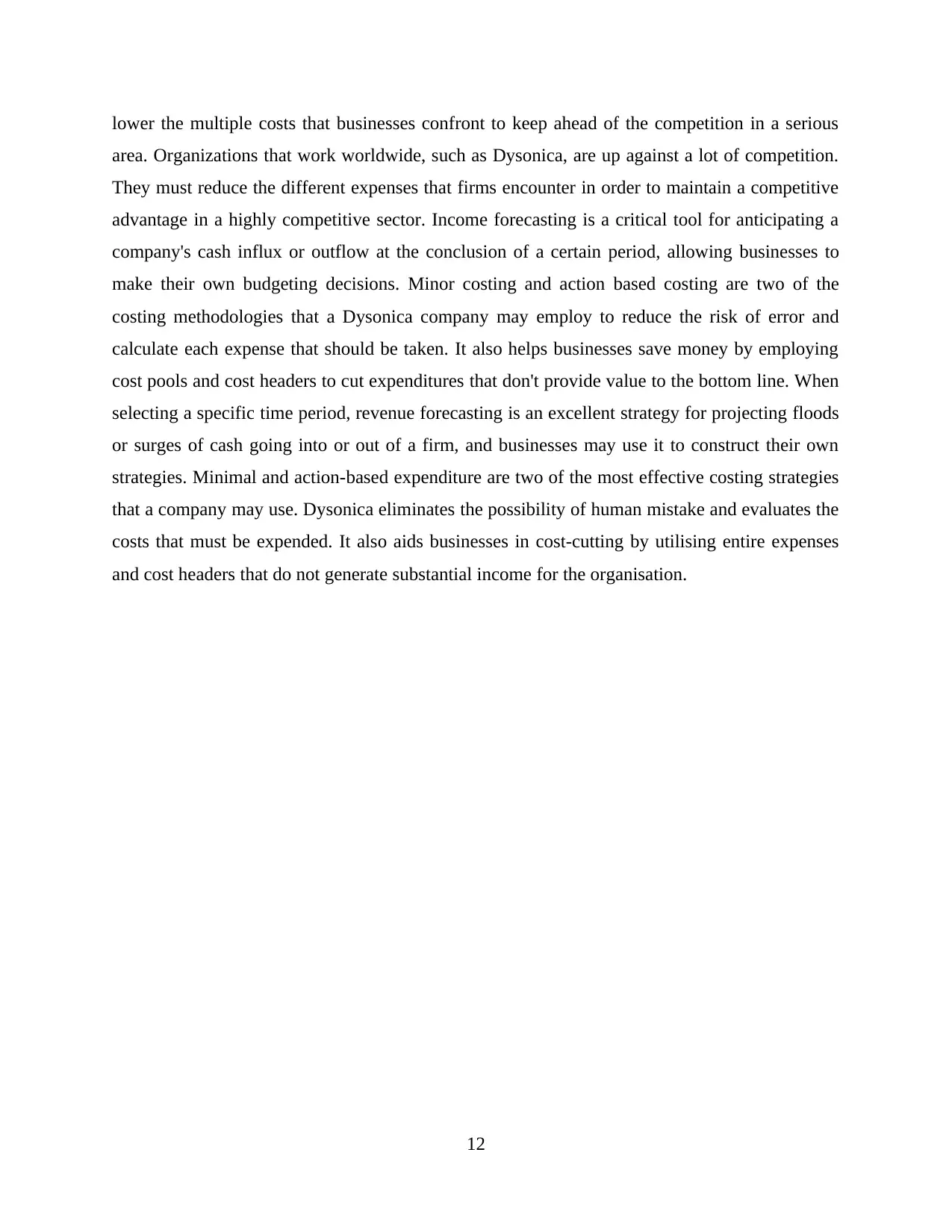
lower the multiple costs that businesses confront to keep ahead of the competition in a serious
area. Organizations that work worldwide, such as Dysonica, are up against a lot of competition.
They must reduce the different expenses that firms encounter in order to maintain a competitive
advantage in a highly competitive sector. Income forecasting is a critical tool for anticipating a
company's cash influx or outflow at the conclusion of a certain period, allowing businesses to
make their own budgeting decisions. Minor costing and action based costing are two of the
costing methodologies that a Dysonica company may employ to reduce the risk of error and
calculate each expense that should be taken. It also helps businesses save money by employing
cost pools and cost headers to cut expenditures that don't provide value to the bottom line. When
selecting a specific time period, revenue forecasting is an excellent strategy for projecting floods
or surges of cash going into or out of a firm, and businesses may use it to construct their own
strategies. Minimal and action-based expenditure are two of the most effective costing strategies
that a company may use. Dysonica eliminates the possibility of human mistake and evaluates the
costs that must be expended. It also aids businesses in cost-cutting by utilising entire expenses
and cost headers that do not generate substantial income for the organisation.
12
area. Organizations that work worldwide, such as Dysonica, are up against a lot of competition.
They must reduce the different expenses that firms encounter in order to maintain a competitive
advantage in a highly competitive sector. Income forecasting is a critical tool for anticipating a
company's cash influx or outflow at the conclusion of a certain period, allowing businesses to
make their own budgeting decisions. Minor costing and action based costing are two of the
costing methodologies that a Dysonica company may employ to reduce the risk of error and
calculate each expense that should be taken. It also helps businesses save money by employing
cost pools and cost headers to cut expenditures that don't provide value to the bottom line. When
selecting a specific time period, revenue forecasting is an excellent strategy for projecting floods
or surges of cash going into or out of a firm, and businesses may use it to construct their own
strategies. Minimal and action-based expenditure are two of the most effective costing strategies
that a company may use. Dysonica eliminates the possibility of human mistake and evaluates the
costs that must be expended. It also aids businesses in cost-cutting by utilising entire expenses
and cost headers that do not generate substantial income for the organisation.
12
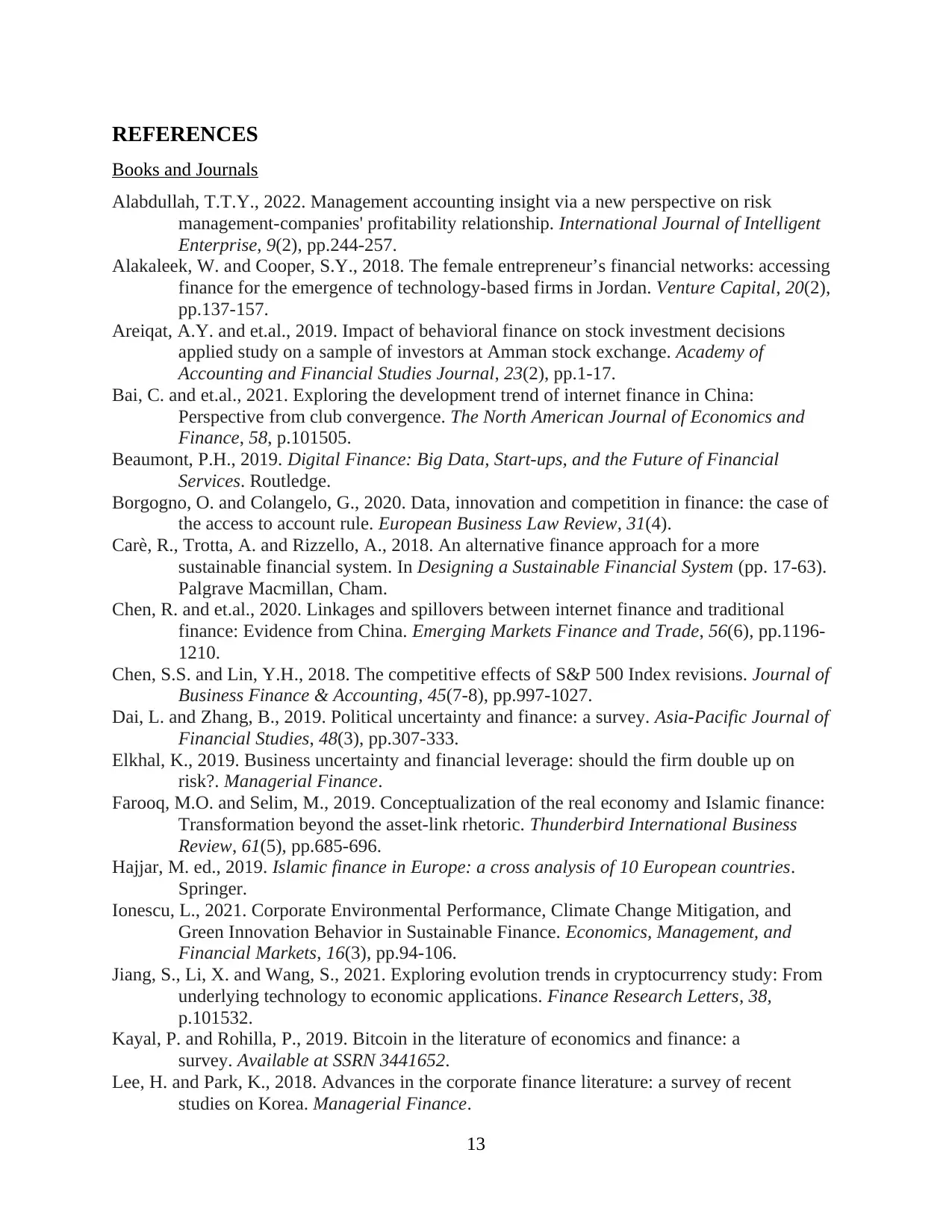
REFERENCES
Books and Journals
Alabdullah, T.T.Y., 2022. Management accounting insight via a new perspective on risk
management-companies' profitability relationship. International Journal of Intelligent
Enterprise, 9(2), pp.244-257.
Alakaleek, W. and Cooper, S.Y., 2018. The female entrepreneur’s financial networks: accessing
finance for the emergence of technology-based firms in Jordan. Venture Capital, 20(2),
pp.137-157.
Areiqat, A.Y. and et.al., 2019. Impact of behavioral finance on stock investment decisions
applied study on a sample of investors at Amman stock exchange. Academy of
Accounting and Financial Studies Journal, 23(2), pp.1-17.
Bai, C. and et.al., 2021. Exploring the development trend of internet finance in China:
Perspective from club convergence. The North American Journal of Economics and
Finance, 58, p.101505.
Beaumont, P.H., 2019. Digital Finance: Big Data, Start-ups, and the Future of Financial
Services. Routledge.
Borgogno, O. and Colangelo, G., 2020. Data, innovation and competition in finance: the case of
the access to account rule. European Business Law Review, 31(4).
Carè, R., Trotta, A. and Rizzello, A., 2018. An alternative finance approach for a more
sustainable financial system. In Designing a Sustainable Financial System (pp. 17-63).
Palgrave Macmillan, Cham.
Chen, R. and et.al., 2020. Linkages and spillovers between internet finance and traditional
finance: Evidence from China. Emerging Markets Finance and Trade, 56(6), pp.1196-
1210.
Chen, S.S. and Lin, Y.H., 2018. The competitive effects of S&P 500 Index revisions. Journal of
Business Finance & Accounting, 45(7-8), pp.997-1027.
Dai, L. and Zhang, B., 2019. Political uncertainty and finance: a survey. Asia‐Pacific Journal of
Financial Studies, 48(3), pp.307-333.
Elkhal, K., 2019. Business uncertainty and financial leverage: should the firm double up on
risk?. Managerial Finance.
Farooq, M.O. and Selim, M., 2019. Conceptualization of the real economy and Islamic finance:
Transformation beyond the asset‐link rhetoric. Thunderbird International Business
Review, 61(5), pp.685-696.
Hajjar, M. ed., 2019. Islamic finance in Europe: a cross analysis of 10 European countries.
Springer.
Ionescu, L., 2021. Corporate Environmental Performance, Climate Change Mitigation, and
Green Innovation Behavior in Sustainable Finance. Economics, Management, and
Financial Markets, 16(3), pp.94-106.
Jiang, S., Li, X. and Wang, S., 2021. Exploring evolution trends in cryptocurrency study: From
underlying technology to economic applications. Finance Research Letters, 38,
p.101532.
Kayal, P. and Rohilla, P., 2019. Bitcoin in the literature of economics and finance: a
survey. Available at SSRN 3441652.
Lee, H. and Park, K., 2018. Advances in the corporate finance literature: a survey of recent
studies on Korea. Managerial Finance.
13
Books and Journals
Alabdullah, T.T.Y., 2022. Management accounting insight via a new perspective on risk
management-companies' profitability relationship. International Journal of Intelligent
Enterprise, 9(2), pp.244-257.
Alakaleek, W. and Cooper, S.Y., 2018. The female entrepreneur’s financial networks: accessing
finance for the emergence of technology-based firms in Jordan. Venture Capital, 20(2),
pp.137-157.
Areiqat, A.Y. and et.al., 2019. Impact of behavioral finance on stock investment decisions
applied study on a sample of investors at Amman stock exchange. Academy of
Accounting and Financial Studies Journal, 23(2), pp.1-17.
Bai, C. and et.al., 2021. Exploring the development trend of internet finance in China:
Perspective from club convergence. The North American Journal of Economics and
Finance, 58, p.101505.
Beaumont, P.H., 2019. Digital Finance: Big Data, Start-ups, and the Future of Financial
Services. Routledge.
Borgogno, O. and Colangelo, G., 2020. Data, innovation and competition in finance: the case of
the access to account rule. European Business Law Review, 31(4).
Carè, R., Trotta, A. and Rizzello, A., 2018. An alternative finance approach for a more
sustainable financial system. In Designing a Sustainable Financial System (pp. 17-63).
Palgrave Macmillan, Cham.
Chen, R. and et.al., 2020. Linkages and spillovers between internet finance and traditional
finance: Evidence from China. Emerging Markets Finance and Trade, 56(6), pp.1196-
1210.
Chen, S.S. and Lin, Y.H., 2018. The competitive effects of S&P 500 Index revisions. Journal of
Business Finance & Accounting, 45(7-8), pp.997-1027.
Dai, L. and Zhang, B., 2019. Political uncertainty and finance: a survey. Asia‐Pacific Journal of
Financial Studies, 48(3), pp.307-333.
Elkhal, K., 2019. Business uncertainty and financial leverage: should the firm double up on
risk?. Managerial Finance.
Farooq, M.O. and Selim, M., 2019. Conceptualization of the real economy and Islamic finance:
Transformation beyond the asset‐link rhetoric. Thunderbird International Business
Review, 61(5), pp.685-696.
Hajjar, M. ed., 2019. Islamic finance in Europe: a cross analysis of 10 European countries.
Springer.
Ionescu, L., 2021. Corporate Environmental Performance, Climate Change Mitigation, and
Green Innovation Behavior in Sustainable Finance. Economics, Management, and
Financial Markets, 16(3), pp.94-106.
Jiang, S., Li, X. and Wang, S., 2021. Exploring evolution trends in cryptocurrency study: From
underlying technology to economic applications. Finance Research Letters, 38,
p.101532.
Kayal, P. and Rohilla, P., 2019. Bitcoin in the literature of economics and finance: a
survey. Available at SSRN 3441652.
Lee, H. and Park, K., 2018. Advances in the corporate finance literature: a survey of recent
studies on Korea. Managerial Finance.
13
Paraphrase This Document
Need a fresh take? Get an instant paraphrase of this document with our AI Paraphraser
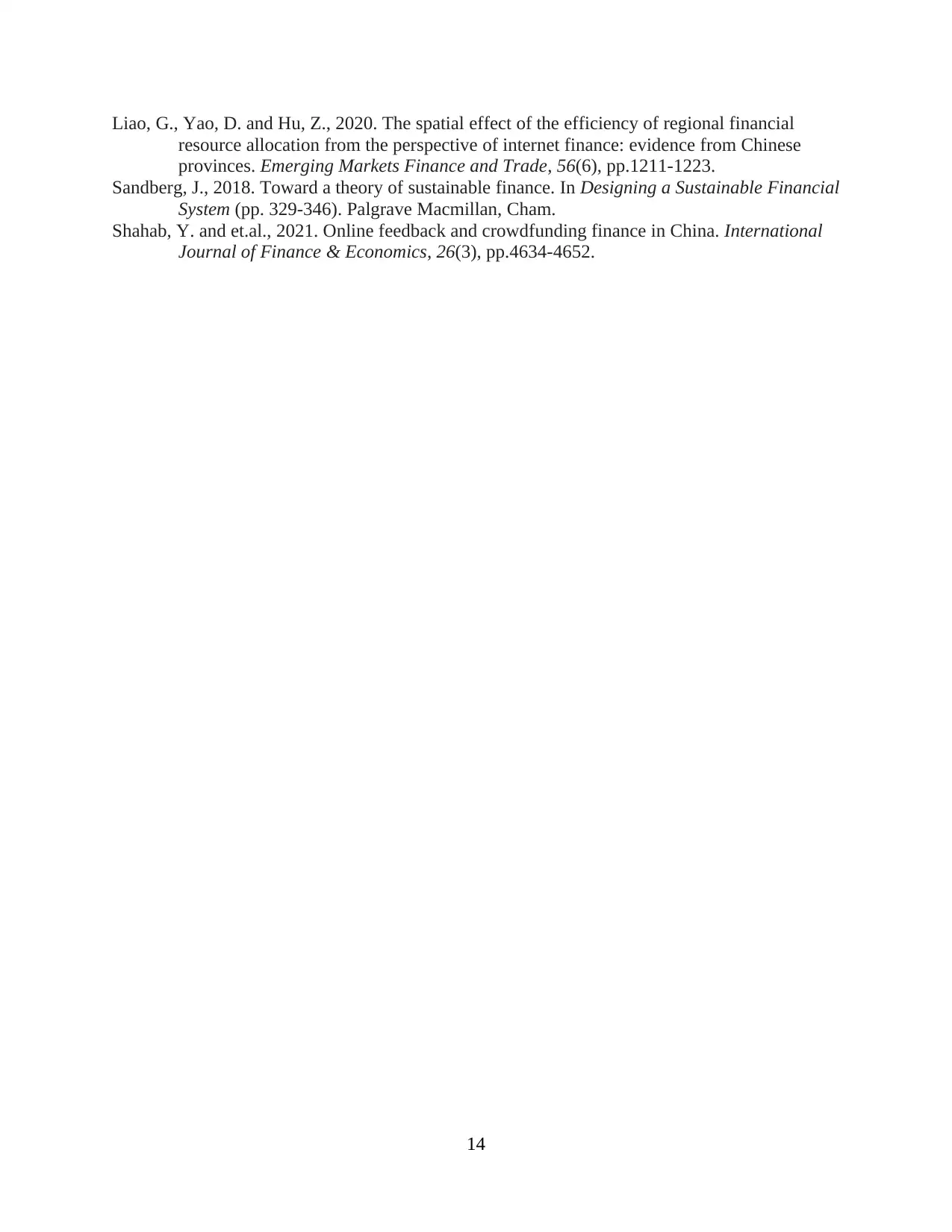
Liao, G., Yao, D. and Hu, Z., 2020. The spatial effect of the efficiency of regional financial
resource allocation from the perspective of internet finance: evidence from Chinese
provinces. Emerging Markets Finance and Trade, 56(6), pp.1211-1223.
Sandberg, J., 2018. Toward a theory of sustainable finance. In Designing a Sustainable Financial
System (pp. 329-346). Palgrave Macmillan, Cham.
Shahab, Y. and et.al., 2021. Online feedback and crowdfunding finance in China. International
Journal of Finance & Economics, 26(3), pp.4634-4652.
14
resource allocation from the perspective of internet finance: evidence from Chinese
provinces. Emerging Markets Finance and Trade, 56(6), pp.1211-1223.
Sandberg, J., 2018. Toward a theory of sustainable finance. In Designing a Sustainable Financial
System (pp. 329-346). Palgrave Macmillan, Cham.
Shahab, Y. and et.al., 2021. Online feedback and crowdfunding finance in China. International
Journal of Finance & Economics, 26(3), pp.4634-4652.
14
1 out of 14
Related Documents
Your All-in-One AI-Powered Toolkit for Academic Success.
+13062052269
info@desklib.com
Available 24*7 on WhatsApp / Email
![[object Object]](/_next/static/media/star-bottom.7253800d.svg)
Unlock your academic potential
© 2024 | Zucol Services PVT LTD | All rights reserved.




